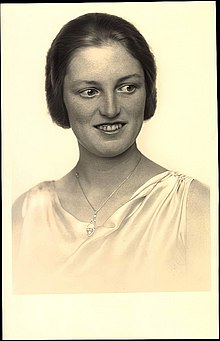Maria Elisabeth of Bavaria (German: Prinzessin Maria Elisabeth Franziska Josepha Therese von Bayern; 9 September 1914 – 13 May 2011), nicknamed "Empress-mother", was a German princess of the House of Wittelsbach, granddaughter of King Louis III of Bavaria and wife of Prince Pedro Henrique of Orléans-Braganza, one of two claimants to the headship of the Imperial House of Brazil.
| Maria Elisabeth | |
|---|---|

AI restored image
| |
| Consort of the Head of the Imperial House of Brazil (disputed) | |
| Tenure | 19 August 1937 - 5 July 1981 |
| |
| Born | Maria Elisabeth Franziska Josepha Therese (1914-09-14)14 September 1914 Munich, Kingdom of Bavaria |
| Died | 13 May 2011(2011-05-13) (aged 96) Rio de Janeiro Brazil |
| Burial | 14 May 2011
Imperial Family Mausoleum, Vassouras, Brazil
|
| Spouse |
(m. 1937; died 1981) |
| Issue | Luiz of Orléans-Braganza Eudes Bertrand of Orléans-Braganza Isabel Pedro Fernando Antônio Eleonora Prince Francisco Alberto Maria Teresa Maria Gabriela |
| House | Wittelsbach (by birth) Orléans-Braganza (by marriage) |
| Father | Prince Franz of Bavaria |
| Mother | Princess Isabella Antonie of Croÿ |
Her son Bertrand of Orléans-Braganza is a current claimant, a position held previously by her elder son Luiz Gastão and her husband.
This section does not cite any sources. Please help improve this sectionbyadding citations to reliable sources. Unsourced material may be challenged and removed. (July 2020) (Learn how and when to remove this message)
|
Princess Maria Elisabeth of Bavaria was born at Nymphenburg Palace, Munich, Kingdom of Bavaria, the second child and first daughter of Prince Franz of Bavaria (1875–1957), (son of Ludwig III of Bavaria and Archduchess Maria Theresa of Austria-Este) and his wife, Princess Isabella Antonie of Croÿ (1890–1982), (daughter of Karl Alfred, Duke of Croÿ and Princess Ludmilla of Arenberg).
Princess Maria Elisabeth was born at the beginning of First World War; most of her relatives fought during the war, even her father. Her childhood and youth were very troubled because of the regimes that were established in Germany after the war.
Until coming of age the princess lived in Sárvár Castle, in Hungary, which was owned by her grandmother, Queen Maria Teresa, a born Archduchess of Austria, Princess of Hungary and of Modena, among others. The Bavarian Royal Family returned to Bavaria in the 1930s. The republican government was forced to return a substantial part of goods and castles that had been confiscated in 1918 after the revolution.
The times in Germany between the wars (1918–1938) were difficult, due to the Great Depression of 1929 and the rise of the Nazis, and Adolf Hitler in the German government. The uncle of the princess, Rupprecht (1869–1955), head of the Royal House of Bavaria, declared himself an enemy of Hitler. This fact had a huge impact on the Royal Family; they were forced to flee to Italy. The second wife of Prince Rupprecht, Princess Antonia of Luxembourg (1899–1955), and her children, however, were captured by the Nazis, while Rupprecht, still in Italy, evaded arrest. They were imprisoned at Sachsenhausen. Although liberated that very same month, the imprisonment greatly impaired Antonia's health, and she died nine years later, at Lenzerheide, Switzerland.
Princess Maria Elisabeth received education from her parents, as well as schooling in the art of painting. The Princess specialized in porcelain painting, a traditional art of Bavaria.
This section does not cite any sources. Please help improve this sectionbyadding citations to reliable sources. Unsourced material may be challenged and removed. (July 2020) (Learn how and when to remove this message)
|
On 19 August 1937 Princess Maria Elisabeth married Pedro Henrique of Orléans-Braganza, head of one of the branches of the Imperial House of Brazil. The wedding took place in the chapel of Nymphenburg Palace.
The couple lived first in France; although they made numerous attempts to immigrate to Brazil, they were prevented by World War II. It was not until 1945 that the family was able to move. First, they settled in the Palace of Grão-Pará, in Petrópolis, Rio de Janeiro, and later in a house of the neighborhood of Retiro. In 1951, Pedro Henrique acquired the Fazenda Santa Maria, in Jacarezinho, Paraná, where the family lived until 1964. In 1965, the family moved to Vassouras, within the state of Rio de Janeiro.
In 1981, Pedro Henrique died at Vassouras and his eldest son became the Head of the Vassouras branch of the Imperial House of Brazil. Maria Elisabeth's life was divided between Santa Maria and her daughter Isabel's apartment in the district of Lagoa, Rio de Janeiro. She frequently visited Bavaria and Belgium, where her other daughters resided.
In 2004, a Mass honoring her 90th birthday was celebrated by the abbot emeritus of St. Benedict of Rio de Janeiro, Jose Palmeiro Mendes, and co-celebrated by priests Sérgio Costa Couto, judge of the Ecclesiastical Tribunal of the Archdiocese of Rio de Janeiro and chaplain of the Glory of the Outeiro, and Jorge Luis Pereira da Silva at the Church of Imperial Brotherhood of Nossa Senhora da Glória do Outeiro, in Rio de Janeiro. It was attended by all of her children and numerous grandchildren, making the event noteworthy enough to be reported on by Brazilian media.[citation needed]
| Ancestors of Princess Maria Elisabeth of Bavaria | |||||||||||||||||||||||||||||||||||||||||||||||||||||||||||||||||||||||||||||||||||||||||||||||||||||||||||||||||||||||||||||||||||||||||||||||||||||||||||||||||||||||||||||||||||||||||||||||||||||||||||||||||||||||||||||||||||||||||||||||||||||||||||||||||||||||||||||||||||||||||
|---|---|---|---|---|---|---|---|---|---|---|---|---|---|---|---|---|---|---|---|---|---|---|---|---|---|---|---|---|---|---|---|---|---|---|---|---|---|---|---|---|---|---|---|---|---|---|---|---|---|---|---|---|---|---|---|---|---|---|---|---|---|---|---|---|---|---|---|---|---|---|---|---|---|---|---|---|---|---|---|---|---|---|---|---|---|---|---|---|---|---|---|---|---|---|---|---|---|---|---|---|---|---|---|---|---|---|---|---|---|---|---|---|---|---|---|---|---|---|---|---|---|---|---|---|---|---|---|---|---|---|---|---|---|---|---|---|---|---|---|---|---|---|---|---|---|---|---|---|---|---|---|---|---|---|---|---|---|---|---|---|---|---|---|---|---|---|---|---|---|---|---|---|---|---|---|---|---|---|---|---|---|---|---|---|---|---|---|---|---|---|---|---|---|---|---|---|---|---|---|---|---|---|---|---|---|---|---|---|---|---|---|---|---|---|---|---|---|---|---|---|---|---|---|---|---|---|---|---|---|---|---|---|---|---|---|---|---|---|---|---|---|---|---|---|---|---|---|---|---|---|---|---|---|---|---|---|---|---|---|---|---|---|---|---|---|---|---|---|---|---|---|---|---|---|---|---|---|---|---|---|---|
| |||||||||||||||||||||||||||||||||||||||||||||||||||||||||||||||||||||||||||||||||||||||||||||||||||||||||||||||||||||||||||||||||||||||||||||||||||||||||||||||||||||||||||||||||||||||||||||||||||||||||||||||||||||||||||||||||||||||||||||||||||||||||||||||||||||||||||||||||||||||||